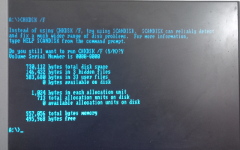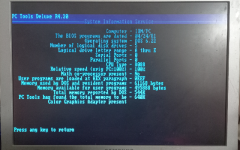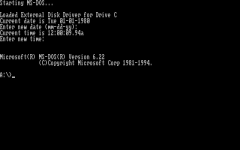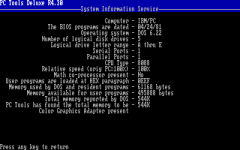As you know, the IBM PC 5150 Rev.0 (04/24/81), Rev.1 (10/19/81) BIOS has a bug that does not recognize the 5th bit in SW2 setting.
Therefore, it is already known that the maximum recognizable RAM capacity is up to 544KB.
But here something amazing happened. After obtaining MicroRAM, after setting it to 640KB, I tested it after plugging it into the slot of the IBM PC 5150 Rev.0 motherboard.
MS-DOS recognized up to 544KB, but when I ran PC-Tools 4.3, the total amount of memory found was 640KB instead of 544KB.
I compared the screenshot I took with a digital camera and the one I ran on the PCE IBM PC 5150, the only emulator that recognizes up to 544KB. In PCE, if you set it to 640KB, it can only recognize 128KB.
The reason is that 640KB is based on Rev.2 (10/27/82) BIOS. The bit corresponding to bit 1/2/3/4/5 of SW2 becomes 1 0 1 1 0, so it is 640 KB.
It is normal to be recognized. However, because Rev.0/1 BIOS does not recognize bit 5 Eventually, the number corresponding to the 4th bit becomes 1 0 1 1, which is Because it corresponds to 128KB, the PCE emulation requires a BIOS corresponding to Rev.0/1
When using, if the memory exceeds 544KB, a bug that the memory is not recognized correctly occurs.
Coming back to the real thing, I think this is very interesting.
The fact that PC-Tools 4.3 recognizes the total memory as 640KB. In the future, by properly analyzing this part, will it be possible to recognize and use up to 640 KB by software?
It is unknown at this time, but it is clear thanks to MicroRAM and PC-Tools.
In the meantime, as a model adopting the IBM PC 5150 Rev.0/Rev.1 BIOS, which has been limited to 544KB, I wonder when it will be used up to 640KB.
P.S. No another emulator can be implemented with 544KB RAM and 100% CPU speed for 8088 except PCE.
1) Real machine



2) PCE IBM PC emulator



Therefore, it is already known that the maximum recognizable RAM capacity is up to 544KB.
But here something amazing happened. After obtaining MicroRAM, after setting it to 640KB, I tested it after plugging it into the slot of the IBM PC 5150 Rev.0 motherboard.
MS-DOS recognized up to 544KB, but when I ran PC-Tools 4.3, the total amount of memory found was 640KB instead of 544KB.
I compared the screenshot I took with a digital camera and the one I ran on the PCE IBM PC 5150, the only emulator that recognizes up to 544KB. In PCE, if you set it to 640KB, it can only recognize 128KB.
The reason is that 640KB is based on Rev.2 (10/27/82) BIOS. The bit corresponding to bit 1/2/3/4/5 of SW2 becomes 1 0 1 1 0, so it is 640 KB.
It is normal to be recognized. However, because Rev.0/1 BIOS does not recognize bit 5 Eventually, the number corresponding to the 4th bit becomes 1 0 1 1, which is Because it corresponds to 128KB, the PCE emulation requires a BIOS corresponding to Rev.0/1
When using, if the memory exceeds 544KB, a bug that the memory is not recognized correctly occurs.
Coming back to the real thing, I think this is very interesting.
The fact that PC-Tools 4.3 recognizes the total memory as 640KB. In the future, by properly analyzing this part, will it be possible to recognize and use up to 640 KB by software?
It is unknown at this time, but it is clear thanks to MicroRAM and PC-Tools.
In the meantime, as a model adopting the IBM PC 5150 Rev.0/Rev.1 BIOS, which has been limited to 544KB, I wonder when it will be used up to 640KB.
P.S. No another emulator can be implemented with 544KB RAM and 100% CPU speed for 8088 except PCE.
1) Real machine



2) PCE IBM PC emulator



